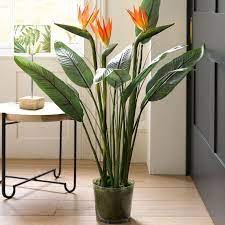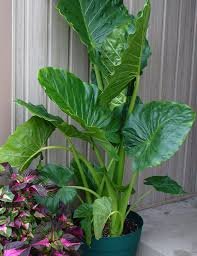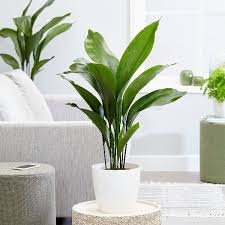Are you looking forward to big- leaf Houseplant that will compliment your kitchen décor? If so, you are landing in just the right place! Houseplants with big green leaves make an eye-catching and astonishing statement in the kitchen. Their remarkable and rich foliage is a reasonable and satisfactory way to brighten up your kitchen space.
You can transform your kitchen into an indoor jungle oasis with these stunning houseplants. Here, you will find 10 majestic indoor plants that can make dazzling your dark corner of the kitchen and could be the perfect addition to your own indoor garden. Let’s take a glance at our dearest big-leaf indoor plants for the kitchen.
African Mask ( big-leaf Houseplant)

The African Mask Plant is a trendy houseplant feature by large dark green heart-shaped leaves with waxy edges. These heart-shaped leaves are magnified by deep silvery white or mint green veining with a splash of purple inside. The African Mask plant is basically native to the Philippines and got its name due to its big leaf foliage which is similar to African Mask. It is also known as Alocasia Polly. If you planted this gorgeous plant outdoors, it will provide vibrant orange berries which are harmful to the health of humans and pets.
Basic Care guide for the African Mask Plant
- African Mask Plant does their best in bright indirect light so, place it near the south-facing window of your kitchen. Keep away it from the harsh direct sunlight because it may burn the beauty of your green friend.
- Water your elegant plant regularly during the active growing season (spring and summer). When 2 inches of soil feel dry out to the touch then it is time to water your African Mask Plant. Avoid overwatering because it can kill your sensitive plant.
- You can use a 3-inch plastic pot with well-draining soil for the African Mask plant because it will hold moisture longer.
- If you wish to thrive your plant for a longer time then repot it in fresh soil every year.
Banana Tree (big-leaf Houseplant)

This tropical pet-friendly indoor plant is one of the glamorous plants. It is an ideal and beautiful addition to your collection and in the heart of your house. Its huge and glossy yellowish-green paddle-shaped leaves with a large trunk bestow your kitchen with a natural look. If you have a huge space in your kitchen, a banana plant can become your dreamy plant and it can nourish your family with different varieties of bananas.
Unique Varieties of Banana to grow indoor
- Blue Java Banana
They can grow up to 15 to 20 ft. Height. They are spongy in texture and juicy in taste while bluish-green or bluish-silver in color. You can use this type of banana for making fruit trifles, pancakes, and muffins.
- Red Banana
Red bananas are also known as Red Dacca. They are stunning pinkish inside and reddish-purple outside. They have a creamy texture and are sweeter as compared to yellow bananas. It is an excellent source of vitamin C, potassium, and fiber. Consuming red bananas can save you from kidney stones.
- Cavendish Banana
Cavendish bananas are green in color when they are unripe, bright yellow when they are ripe, and brown when they are spoiled. They have an oily texture and heavenly sweet taste. This is not the best type to grow indoors because they have large thin leaves and require vast space to thrive.
How to Grow and Care for your Banana Plant?
- The banana plant loves to thrive in full exposure to the sun instead of indirect light. Place it where it can get a lot of sunlight. When a banana plant can’t receive enough sunlight during cold freezing days of winter, just place it under the growing lamp which helps it to stay healthy and energetic.
- Banana plants prefer warm temperatures and humidity. Indoor temperature between 67- 90 degrees F is acceptable for Banana plants and keep away your tropical plant from drafty areas.
- When 2 inches of soil feel dry out to the touch then it is time to water your Banana Plant. Avoid overwatering because it can kill your tropical plant. Keep the soil moist but not soggy.
- Provide a healthy dose of fertilizer to your banana plant once a month.
- Sometimes, your plant may suffer from leaf diseases like powdery mildew due to high humidity levels in the absence of airflow. In this case, remove the affected leaves and let a fan gently blow over the leaves.
Bird of paradise (big-leaf Houseplant)

Bird of paradise is one of the most popular and demanding indoor tropical flowering plants and is native to South Africa. It earned its unique name due to its flower shape which resembles bird wings. This tropical indoor plant can reach up to 6-7 feet tall and 4 feet wide at maturity level. Bird of paradise may toxic for humans, your fur babies, dogs (faithful animals), and horses. This tropical plant has thick and large deep green waxy leaves which scatter out in the form of layers from the central stalk.
How to grow and Care for Bird of paradise?
- Keep the soil moist but not soggy for the pleasure and satisfaction of your bird of paradise. You can use a soil probe tool to check the moisture level in the soil and allow the top 2-3 inches of soil to dry out before watering again.
- Protect your tropical green friend from drafty areas and provide a high humidity level with the help of a humidifier otherwise, you notice signs of stress in the growth of your green friend.
- Bird of paradise prefers slightly acidic, loamy, and well-drained soil to grow properly.
- This tropical plant appreciates the direct light of the morning sun and semi-shade in the afternoon.
Elephant Ear ( big-leaf Houseplant)

This low-maintenance and tropical plant is native to South America. The elephant ear plant earned its name from its large and arrowhead-shaped leaves. They are commonly grown outdoors but also do their best in pots. Elephant Ear plants come in numerous varieties of colors and sizes. Keep away it from pets because it can toxic if ingested.
How to Grow and Care for your Elephant Ear Plant?
- Elephant Ear Plant does their best in bright indirect light so, place it near the south-facing window of your kitchen. Keep away from the harsh direct sunlight because it may burn the beauty of your green friend.
- Elephant Ear plant loves warm weather and hates freezing cold temperature because they can kill the beauty of foliage and demolish tubers.
- When 2 inches of soil feel dry out to the touch then it is time to water your green friend. Avoid overwatering because it can kill your tropical plant. Keep the soil moist but not soggy.
Cast Iron Plant (Aspidistra Elatior)

Cast Iron Plant is one of the most beloved houseplants that have arching and large deep green leaves. Because it is as sturdy and unyielding as a cast iron pan, the cast iron plant earned its name. It is best for indoor because it can thrive appropriately in dim light. Its dark green and glistening leaves make your kitchen more beautiful. Be patient about it because it requires more time to grow.
How to Grow and Care for your Cast Iron Plant?
- This plant loves soil that is a little moist but hates soggy.
- You should not keep it at a shallow temperature.
- You can keep Cast iron Plant anywhere in the home because it is not toxic for pets.
- If you notice that the leaves of cast Iron plants turn light brown, then keep away from the tropical and dazzling rays of the sun.
- To ensure the soil is arid before watering, always check.
Chinese evergreen Plant

The botanical name of the Chinese evergreen plant is Aglaonema spp. Chinese evergreen plant is one of the big-leaf houseplants with large glossy and pointed leaves. This outstanding kitchen plant is native to the tropical and subtropical forests of Asia and New Guinea. The silver bay is one of the most common varieties of Chinese evergreen plants. Spruce up the kitchen with the natural beauty of Chinese evergreen plants.
How do grow and Care for Chinese evergreen Plants?
- Always keep Chinese evergreen plant away from pets because it contains calcium oxalate that is toxic to pets.
- Keep soil moist but always allow the soil to become dry before watering. Yellow leaves may be a sign of copper deficiency and overwatering.
- Make sure that the plant gets a sufficient amount of water and raises the humidity level otherwise fresh green leaves of the plant will turn a brown color.
- It feels comfortable in indirect light.
- Don’t over-fertilization of your plant otherwise you face curled leaves of the plant. It takes more time for growth as compared to others houseplants.
Spider Plant | big-leaf Houseplant

Spider plants have a green and white rosette of long thin leaves, which gives the plant a unique look. It has excellent proficiency in purifying the air of pollutants and eradicating different stinking odors. If you really like to maintain your kitchen free from fragrances and poisonous smoke, then the Spider plant is vital for your kitchen.
Benefits of Spider Plant
- Spider plants are also a significant source of increasing humidity and decreasing stress levels.
- Spider plants add bright colors to your life and make you satisfied.
- It is easy to grow because it does not require more water and light.
- Place spider plants in your kitchen and breathe in an ozone-free environment.


